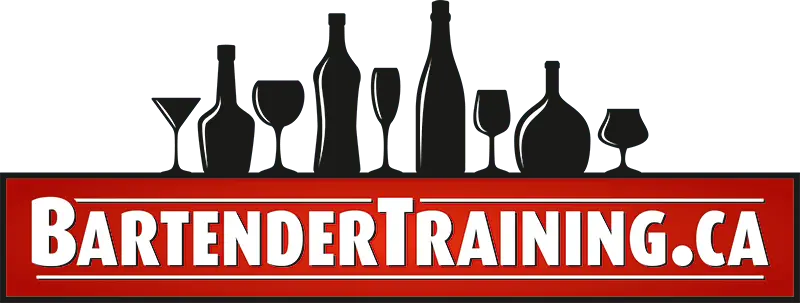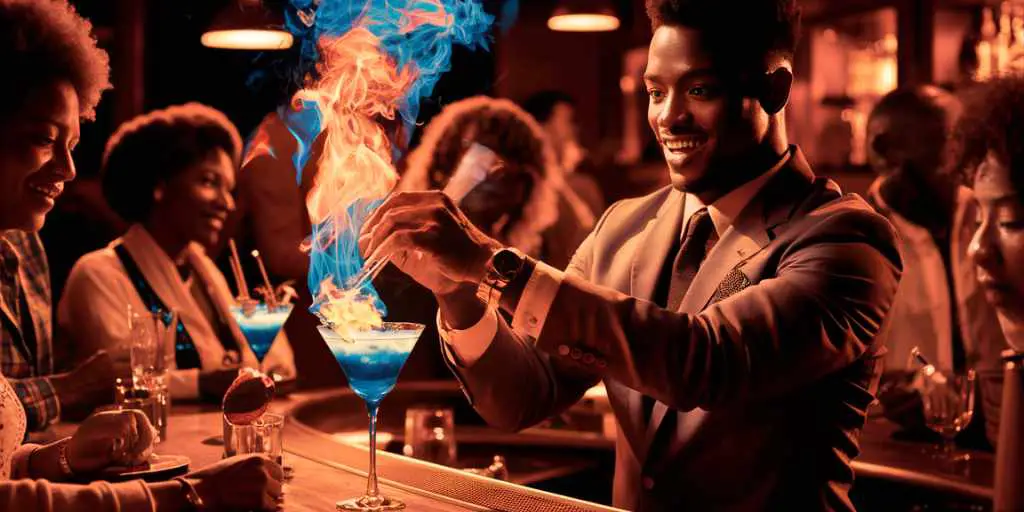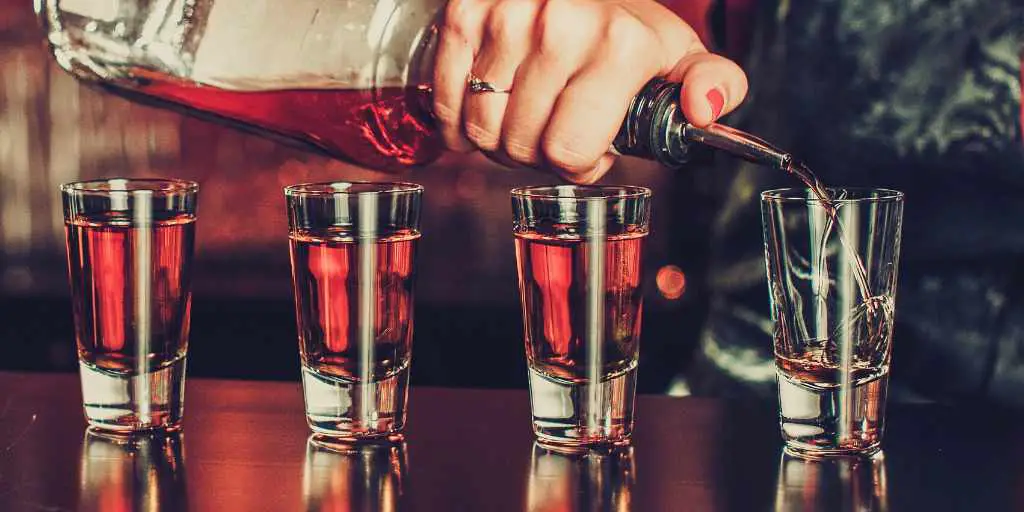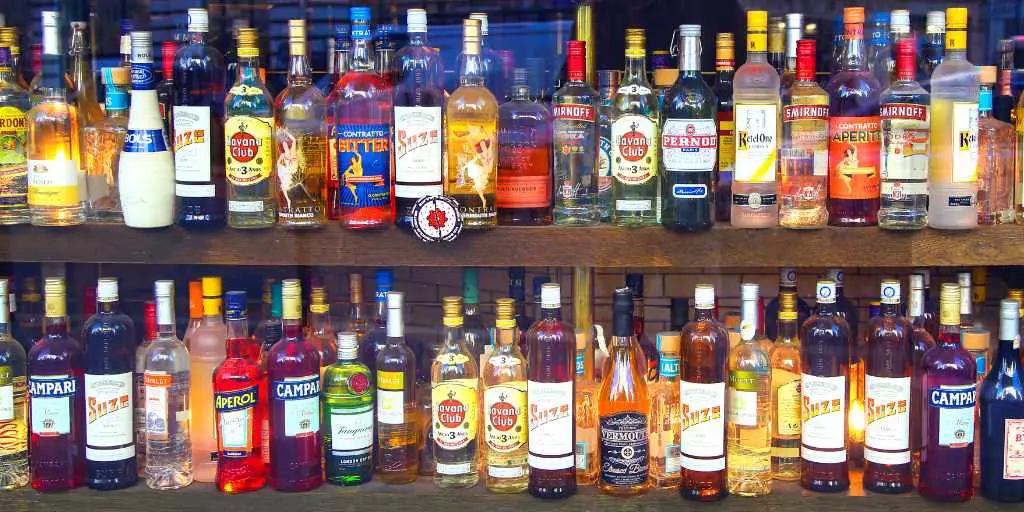Bartending is more than just pouring drinks; it’s an art form that blends creativity with skill. Successful bartenders know that engaging their guests is as important as making a great cocktail. To do so, many bartenders turn to flair bartending, where they perform tricks that enhance the experience of their guests. These tricks, when executed with precision and style, not only entertain but also showcase a bartender’s proficiency and confidence behind the bar.
Key Takeaways
- Bartending combines drink-making skill with an engaging guest experience.
- Mastery of bartending techniques requires practice and a flair for entertainment.
- Advanced bartending skills can elevate the atmosphere of a bar and leave lasting impressions.
The Art of Flair Bartending
Flair bartending combines the efficiency of mixology with the visual appeal of performance, where mastery is achieved through consistent practice and the expression of one’s unique style.
Fundamentals of Flair Bartending
The bedrock of flair bartending lies in its foundation skills, which every aspiring bartender must cultivate. Two critical elements for a successful flair performance are concentration and balance. It’s essential for bartenders to invest time in practice to refine their skills before performing. Understanding the mechanics of each trick, from grip to motion, is vital for safety and fluidity in their routines.
- Essential Skills:
- Hand-eye coordination: Ensures precision in tricks and performance.
- Timing and rhythm: Crucial for smooth transitions between tricks.
- Spatial awareness: Helps in executing complex manoeuvres without accidents.
Popular Flair Bartending Moves
Several flair tricks have gained popularity among flair bartenders due to their visual impact and the entertainment they provide. Some notable moves include:
- The Bottle Flip: A classic move where the bottle is tossed into the air and caught.
- The Pour Cut: Involves cutting off the liquid flow with a swift motion.
- The Stall: Balancing an object on the hand, forearm, or another surface.
Bartenders looking to learn these moves can find resources like Master The Art Of Flair Bartending for step-by-step guidance.
Developing Your Own Style
For flair bartenders, developing a signature style goes beyond replicating tricks; it’s about personal expression and adding an individual twist to performances. They are encouraged to augment standard tricks with their own flair to create a memorable entertaining experience. A strong personal style resonates with audiences and can become a bartender’s trademark.
Tips for Personal Style Development:
- Experiment with different moves and combine them creatively.
- Incorporate elements of personal interests or hobbies into performances.
Employing flair in bartending not only enhances the overall experience but also showcases the bartender’s skills and dedication to their craft. Through practice and the development of a unique style, flair bartenders elevate the art of drink service into an engaging performance.
Mastering the Craft of Mixing Drinks
In bartending, the quality of mixed drinks hinges on precise technique, proper equipment, and the artful presentation. Bartenders must have a thorough understanding of each element to excel in the craft.
Essential Bartending Tools
To mix drinks effectively, bartenders equip themselves with specific tools designed to enhance efficiency and accuracy. Cocktail shakers are indispensable for combining ingredients like liquor, juice, and ice through vigorous shaking, which chills and dilutes the drink for optimal taste. A jigger allows for precise measurement of spirits and other mixers, ensuring the flavor of cocktails remains consistent. Various glasses cater to different types of cocktails, like highball glasses for long drinks or martini glasses for classic serves, affecting both the aesthetic and the experience of enjoying the drink.
- Mixing spoon: Long-handled and twisted for smooth stirring.
- Strainer: Removes ice fragments after shaking or stirring.
- Muddler: Crushes herbs or fruit to release fresh flavors.
Cocktail Recipes and Techniques
Understanding cocktail recipes and mastering mixing techniques are fundamental in bartending. The method chosen—be it shaking, stirring, or muddling—impacts a drink’s clarity, dilution, and temperature. For instance, a martini benefits from stirring to maintain clarity, while a margarita is best shaken to achieve a frothy texture. An adept bartender uses syrup, fruit, or herbal essences to introduce distinct flavors and pairs the appropriate liquor or spirit to create nuanced and memorable cocktails.
Here are a few techniques:
- Shaking: Used for incorporating opaque or thick ingredients like cream or egg.
- Stirring: Best for clear cocktails where minimal dilution is desired.
- Layering: Carefully pouring ingredients to create separate layers based on density.
Presentation and Garnishing Tips
The visual aspect of cocktails can be as important as their taste. Bartenders enhance the presentation with carefully chosen garnishes and the correct glassware. A slice of fruit, an edible flower, or a simple citrus twist can elevate the visual appeal and provide a hint of the drink’s flavor profile. When pouring, bartenders aim for a smooth and controlled flow to achieve the perfect serve. For layered drinks, the slow pour over the back of a spoon achieves distinct layers. Glasses should be clean, of the correct type for the drink, and sometimes pre-chilled or prepared with a sugar or salt rim to heighten the overall experience.
- Garnishes: Fresh, complementary, and aesthetically pleasing.
- Glass preparation: Chilling, rimming with salt or sugar, and ensuring cleanliness.
- Pour control: Crucial for accurate mixing and layering of drinks.
Bartending Tricks and Techniques
Bartending tricks serve as an impressive display of skill and dexterity behind the bar, elevating a mixologist’s craft into an art form. Techniques range from basic to advanced and involve various tools, including glassware, to create an engaging experience for patrons.
Classic Bartender Tricks
Bartenders often use eye-catching manoeuvres to entertain guests. The tin flip is a staple trick, where the bartender flips a mixing tin with grace, typically using the back of the hand or an index finger to create a smooth arc before catching it. Mastering the spoon flip involves twirling a bar spoon with fluid motions between the fingers without losing balance or control. These tricks rely on a keen sense of timing and the ability to gauge the weight and momentum of the tools they are working with.
- Examples of Classic Tricks:
- Spoon Flip
- Tin Flip (one hand)
- Bottle Roll
See this article if you want to learn how to do a tin flip or bottle roll.
Advanced Mixing Methods
Advancing beyond the basics, most bartenders who delve into more intricate techniques boost their repertoire immensely. An advanced bartender trick like throwing involves transferring liquids between shakers or glasses from a distance with precision, ensuring no spills or splashes. Balance and pour tricks require the ability to multitask, controlling the flow of the liquid while engaging in another activity such as conversing with a guest or managing multiple drink orders. These methods not only enhance the visual appeal but also demonstrate a professional bartender’s ability to deliver both showmanship and quality.
- Examples of Advanced Methods:
- Two-handed pours
- Liquid throws without a spill
- Synchronized cocktail preparation
Working with Different Types of Glassware

Understanding and utilizing different types of glassware is an extremely versatile skill for bartenders. Executing a trick that matches the glassware enhances the overall presentation of a drink. A tin flip into a snugly fitting glass can demonstrate both precision and flair. Techniques that involve making a glass stick or balance on a surface, possibly stacked, are visually intriguing and showcase a professional bartender’s finesse. Most bartenders become acquainted with glassware tricks after gaining comfort with their grip and the weight distribution of various glasses during their routine use.
Key Points with Glassware:
- Precision glass placement with a flip
- Balancing acts with stacked stemware
- Creative grabs and pulls, integrating glassware into tricks
Incorporating these bartending tricks and techniques not only captivates the audience but also reflects the mixologist’s proficiency and commitment to their craft.
Engaging and Entertaining Your Guests
Bartending is not just about serving drinks; it’s an art form that combines mixology with entertainment. A bartender’s ability to engage and entertain guests can turn a simple drink order into a memorable experience. This section focuses on two core components: interactive skills that involve the guests, and showmanship through party tricks that create an electrifying atmosphere.
Interactive Bartending Skills
An interactive bartender knows that the experience is about more than just handing over a cocktail. By involving guests in the drink-making process, bartenders can make them feel a part of the show. This can be as simple as giving guests a choice of different types of ice for their drink—whether it’s crushed, cubed or spherical—or letting them try their hand at shaking a tin horizontally. Another approach is serving a selection of drinks and encouraging guests to mix and match flavors, creating their own signature cocktails.
Some Specific Techniques:
- Encouraging guests to choose their preferred type of alcohol, whether it’s beer, vodka, or a fancy liqueur.
- Allowing them to select from a variety of garnishes to personalize their cocktails.
- Demonstrating the proper way to taste spirits to highlight the uniqueness of different labels or ages.
Party Tricks and Showmanship
Flair bartending is a performance art that’s guaranteed to captivate any crowd. Mastering party tricks such as flipping a bottle over the shoulder or balancing multiple bottles elevates the act of pouring a drink into a spectacle. Knowing how to execute these tricks proficiently requires practice, but for those interested, watching bar trick video tutorials can be a great place to start.
Key showmanship tactics involve:
- Scene-stealing tin flips, which add dynamism to the next movement of making a drink.
- Serving multiple drinks with intricate pours, such as the swoop cut, thereby showcasing the bartender’s skill and precision.
- Integrating ice tricks, like throwing cubes into the air and catching them in a glass or shaker.
Ultimately, bartenders who can combine interactive skills with party tricks provide not only a drink but an unforgettable experience that’s as enticing to watch as the cocktails are to drink. Whether guests are seeking fun or hoping to learn a bit about mixology, a talented bartender knows that serving with a dash of showmanship is a surefire way to earn those extra tips.
Advanced Bartending: Elevating Your Skills
Advanced bartending encompasses a range of skills that take drink crafting to an exceptional level. Mastery of these techniques can transform an ordinary beverage into a specialty masterpiece, ensuring patrons enjoy a unique and memorable experience.
Specialty Drinks and Unique Mixes
To master advanced bartending is to be able to conjure speciality drinks that boast an exceptional flavour and presentation. The combination of ingredients in these creations often involves a delicate balance that yields surprising and delightful results. Bartenders should focus not just on the taste, but also on the visual appeal and the tactile experience of a drink. Learning to balance the subtleties of unique mixes can distinguish a bartender as a master in their craft. Taking a course or workshop in advanced mixology can be a significant step towards achieving this level of skill.
Learning from the World’s Best Flair Bartenders
Flair bartending is more than a service; it’s a performance that combines agility, juggling, and creativity. Those looking to elevate their flair bartending moves and style often observe and learn from the world’s best flair bartenders. These professionals excel at entertaining guests while preparing beverages, turning drink-making into art. By integrating tips and techniques from renowned bartenders, one can refine their flair skills, making each combination of tosses, spins, and catches seem effortless. The focus should be on seamlessly integrating flair into service, ensuring that the entertainment enhances the drink rather than detracts from its quality.
Frequently Asked Questions

In bartending, mastering specific skills and understanding trade secrets can elevate one’s craft and service. This section dives into common queries to offer practical insights for aspiring and professional bartenders.
How can one learn basic flair bartending skills?
One can learn basic flair bartending skills by practising simple tricks like spinning a bottle in one’s hand or flipping a shaker. Various online tutorials offer step-by-step guidance for beginners.
What techniques can bartenders use to enhance their tip earnings?
Bartenders can enhance their tip earnings by providing exemplary service, engaging with customers, and showcasing their proficiency in drink-making, such as precise pouring techniques.
What are some effective magic tricks for bartenders to entertain guests?
Effective magic tricks for bartenders include classic illusions like the disappearing coin, card tricks, or transforming napkins into various shapes. These can create a memorable experience for guests.
What foundational tricks should every beginner bartender know?
Every beginner bartender should know foundational tricks like shaking cocktails rigorously, using a jigger for accurate measurements, and the correct method of layering drinks.
How do professional bartenders use the 50 rule?
Professional bartenders use the 50 rule to balance efficient service with engaging customer interaction, dedicating approximately 50% of their time to making drinks and the other 50% to creating a rapport with patrons.
What are the 5 P’s in bartending and how do they improve service?
The 5 P’s in bartending are preparation, politeness, professionalism, pace, and patience. Adherence to these principles ensures an efficient and positive experience for guests.
What are bartender tricks called?
Bartender tricks are often referred to as ‘flair bartending’ when they involve showy, acrobatic acts and ‘mixology tricks’ when related to the craft of creating cocktails.
How can I improve my bartending skills?
Improving bartending skills comes from continual practice, staying updated on new drink trends, and seeking feedback from colleagues and customers.
What are the common bartending mistakes?
Common bartending mistakes include overpouring alcohol, ignoring patrons, poor time management, and neglecting cleanliness, which can impact the overall bar experience.




